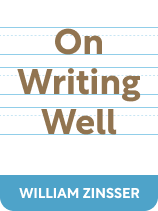

This article is an excerpt from the Shortform book guide to "On Writing Well" by William Zinsser. Shortform has the world's best summaries and analyses of books you should be reading.
Like this article? Sign up for a free trial here .
Do people find your writing too complex or cluttered? Why is simplicity important in writing?
Simple writing is easy for anybody to understand. There’s no need to use a thesaurus to find bigger words, to fluff up your language, or to beat around the bush. The best way to convey your message in writing is to use simple language.
Here are some tips for writing simply and clearly.
How to Write Simply
Simple writing is easy to understand because it uses common and precise words and simple sentence structures.
To write simply, follow these five guidelines:
1. Use Common Words
To avoid confusing your reader, write with smaller, more common words. Zinsser believes that a good rule of thumb is to write like you talk since we generally don’t use words with more than three or four syllables. If you wouldn’t say “pulchritudinous” in conversation with a friend, reconsider using it in your writing.
(Shortform note: Some writing experts offer another reason for using common words: People don’t appreciate feeling illiterate. They argue that writers who use complex words appear to be “showing off” and advise writers to get out of this habit. Researchers support this idea, citing overcomplicated writing and flowery language as a common reason manuscripts are rejected.)
2. Use Precise Words
Simplifying your writing makes your meaning clearer with fewer words. To achieve simplicity, Zinsser advises choosing the best word to suit your meaning and tone. The best word is the one that accurately encapsulates the idea you want to convey. One precise word can do the job of three or four vague words.
Zinsser encourages writers to use a thesaurus and a dictionary when choosing words. Look up synonyms to words in your thesaurus, and use your dictionary to compare the nuances between their meanings. For example, you could describe the sun as “hot,” but also consider writing “boiling” or “scorching.” One word might offer more nuance or meaning than the others, thus making it a better choice.
(Shortform note: While Zinsser encourages both simple and precise word choices, sometimes the most precise word isn’t the simplest or most natural. For example, “susurration” might be more precise, but “murmur” is the simpler choice. Stephen King believes that while an advanced vocabulary can lead to good writing, it isn’t a requirement for it. In your writing, make sure you’re not compromising simplicity by using a more precise—and more complex—word. Instead, find a balance between simplicity and precision, and use words that feel most natural to you.)
3. Construct Simple Sentences
Zinsser also recommends writing with straightforward sentence structures. A simple sentence structure clearly conveys the subject of the sentence and the action the subject is performing. These sentences are easier for readers to follow than a complex sentence structure with, for example, many clauses or references to different ideas, time periods, events, and so on.
(Shortform note: There may be a scientific reason to use simpler sentence constructions. While researchers don’t know everything about how the human brain understands sentence meaning, some experts believe that we speed up the processing of simple sentences since our brains can more easily predict where the sentence is going.)
Zinsser argues that writing in active voice is the easiest way to construct straightforward sentences. Active voice describes a subject performing an action: For example, “John will drive my car.” This differs from passive voice, which describes an event or action that happens to someone: For example, “My car will be driven by John.” Active voice is simpler, more direct, and less cluttered than passive voice, which is wordy and indirect.
| When Should You Use Passive Voice? As Zinsser implies, voice refers to the relationship between a verb and the subject and object it’s associated with. Only use passive voice when the object—not the subject—of the sentence is the focus. Rather than highlighting the subject at the beginning of the sentence using active voice, passive voice flips the sentence around, focusing on the “what,” not the “who” that did the “what.” For instance, lawyers defending someone who committed a crime might use passive voice to intentionally be less direct about the actions of their defendant. For example, instead of saying “Mr. Smith robbed the bank,” a lawyer might say, “The bank was robbed.” Passive voice obscures the focus of who robbed the bank and reframes the sentence onto the object—the bank—of the robbing. |
4. Eliminate Clutter
Zinsser asserts that simple writing can’t have clutter. Clutter is a word or phrase that takes up space but doesn’t add meaning to your sentence. Zinsser believes that it’s your job as a writer to carefully select the right words and delete clutter—this is part of what makes writing a craft. To eliminate clutter from your writing, delete any indirect, wordy, or redundant words and phrases, such as adverbs and euphemisms. Replace these words or phrases with a more succinct term.
(Shortform note: If you’re struggling to delete clutter, try using an online editor like the Hemingway App. This tool highlights hard-to-read sentences, adverbs, passive voice, and other ways your writing may sound confusing. It also lets you evaluate your writing and make thoughtful changes. But be careful not to rely exclusively on these kinds of tools—they shouldn’t be a crutch. Rather, they should help you develop a keener eye for words that aren’t doing necessary work.)
5. Embrace Rewriting
While you should strive to write with simplicity, don’t expect your first draft to be perfect—there will be clutter and imprecise words in your draft. To achieve simplicity, Zinsser recommends embracing rewriting, or the act of improving what you’ve already written. By rewriting, you’ll find better, simplified ways of expressing your ideas.
Zinsser explains that to rewrite, use your first draft as a guide, and restructure confusing sentences. Delete clutter, and rephrase words or sentences that could be more succinct.
Additionally, test the simplicity of your writing by reading your work out loud. Reading your writing out loud will indicate which sentences need reworking. If you trip over words or phrases, it’s a sign to rewrite it more simply.
| Try Stephen King’s Revision Process If you’re having difficulty rewriting—and most writers do—don’t get discouraged. In On Writing, Stephen King outlines his revision process from beginning to end: 1) After you finish your first draft, King suggests taking at least six weeks to work on other pieces before you start rewriting your draft. During this time, resist the temptation to read your draft. The point is to distance yourself from the draft, so you can be a more objective critic when you revise. 2) After six weeks, read the draft in one sitting, if possible. Note fixes for specific issues, like deleting adverbs. Also ask yourself big-picture questions. What is the piece about? Is there a theme? Are there recurring elements? Is the story coherent? 3) Go back through and revise for your second draft. Fix small issues and polish your big picture ideas. 4) After you finish, give the second draft to a small group of readers you trust. Listen to their feedback. Incorporate the feedback as you like. The result can be your next draft, or even your final draft. 5) Use however many revision cycles you’re comfortable with. King’s standard process takes two drafts and a final polish. The next time you sit down to rewrite, consider using King’s process. |

———End of Preview———
Like what you just read? Read the rest of the world's best book summary and analysis of William Zinsser's "On Writing Well" at Shortform .
Here's what you'll find in our full On Writing Well summary :
- A back-to-basics approach to the craft of writing
- How to practice simple, clear, and engaging writing—even if you're not a writer
- How to effectively put your ideas into words






